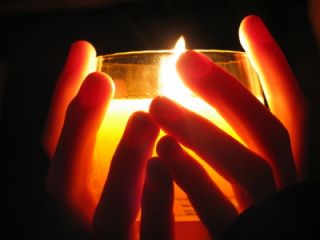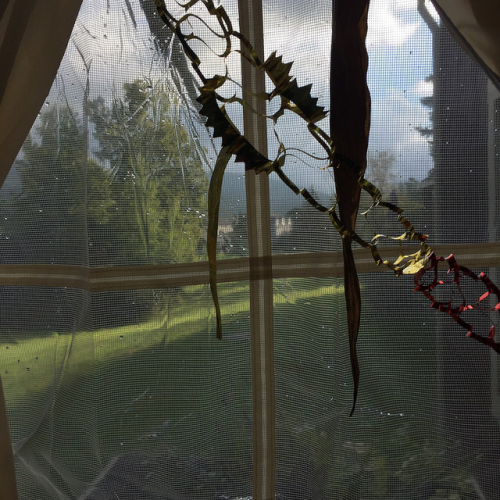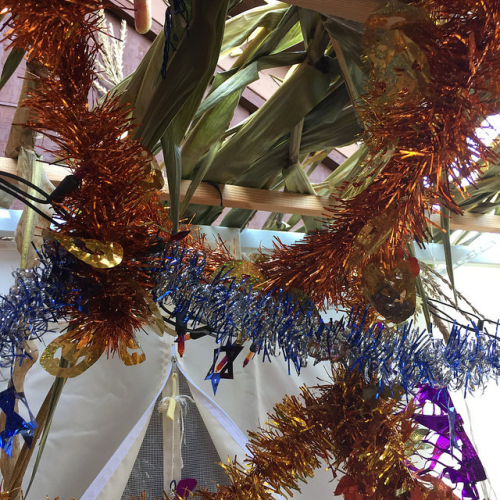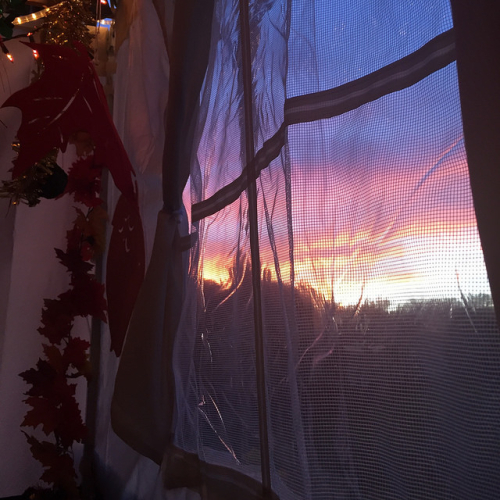Rachel Barenblat's Blog, page 69
October 10, 2018
On denominational and spiritual diversity at @YourBayit
I wrote a post for the About Bayit series on Builders Blog, about one of the facets of who we are, our spiritual differences and why they matter to us. Here's a taste:
...The organization’s founders have roots in, and a track record serving in, every major branch of Judaism from Reform to Orthodoxy. Some of us are proud denominational Jews. Some of us self-identify as post-denominational or trans-denominational Jews. Some of us are both / and Jews, identifying as denominational Jews and as part of the transdenominational Jewish renewal movement. We grew up secular, religious, Reform, Conservative, Reconstructionist, and Orthodox. Those of us who are rabbis attended both denominational seminaries and transdenominational seminaries. Those of us who are laypeople come from backgrounds that span the denominational spectrum too.
Beyond our denominational diversity, we’re also spiritually diverse. Some of us are mystics who write love poetry to the divine, and some of us are rationalists who find most mysticism uncomfortable. Some of us experience God through music, some through liturgy, some through philosophy, some through poetry, and some aren’t sure we experience God at all...
Read the whole thing here: Denominational and spiritual diversity.
(And if you haven't yet subscribed, please do -- just go to Builders Blog and there's a place to enter your email address in the sidebar so you'll receive posts via email. We've just launched a series of weekly Torah commentaries through a building-focused lens that promises to be amazing, and we'll be sharing other kinds of things there in months to come, too. Join us!)

October 7, 2018
On taking action and turning inward
Last night I made the mistake of checking Twitter before bed, and saw tweets from the president and from his lawyer blaming George Soros for ostensibly paying people to protest the Kavanaugh nomination. The tweets suggested that Soros is evil and should be jailed. (I'm not going to link to them; I don't want to give them the attention.)
The claim that Soros pays protestors is ugly falsehood and it has its roots in one of the oldest anti-Semitic canards about global Jewish conspiracy. I expect that all of you who are reading this blog already know that. I don't need to preach to this choir on that front.
But maybe you, like me, are having a panic response to news like this. Intellectually I know that I am safe, that my child is safe, that most of the people I love are safe. But like most Jews of my generation, I grew up on stories of the Holocaust. And when ugly anti-Semitic rhetoric is parroted by the president and by his lawyer, I feel a paralyzing fear in my kishkes, in my gut and in my heart.
I suspect that many of us are feeling that fear. The casual dehumanizing of Jews and Muslims and immigrants and people of color and women that we see in the news and splashed across social media is horrifying. And many Jews carry the accumulated baggage of generations of trauma, including the horrors of the Holocaust, and seeing this stuff in the news and on social media can activate that trauma in us. That's why I'm writing this post. I have four suggestions to offer for how to navigate these difficult times. If you have others, please share them in comments.
1. Take care of yourselves and each other
Take care of yourselves, friends, and take care of each other. Give yourself permission to turn away from social media when you need to, because marinating in a constant bath of outrage and anxiety can do harm. If Twitter and Facebook are raising your anxiety and stoking your fear, it's okay to stop reading them for a while.
If you have the capacity to reach out to others to see how they're doing, do that -- doing so can help both the person who's reaching out, and the person receiving the outreach. (For more wisdom along these lines, here's an excellent piece by Rabbi Danya Ruttenberg on self-care tips for those angered and activated at this moment in time.)
2. Reach out to someone who can help
If you have a therapist or spiritual director, bring the anxiety and fear to them. (If you don't, now might be a good time to find one.) Don't sit with the fear alone -- it's all too easy for fear to consume us when we grapple with it alone. Tell a friend or family member. If you have no one at all to whom you can speak about what you're going through, reach out to the crisis text line.
3. Speak out, when you can - especially when you yourself are not a target
Many of us are oscillating between times when we have the capacity to speak out against injustice, and times when we are activated / hurt / grieving and need others to speak out on our behalf. That night when I was activated by antisemitism, I found comfort in tweets from people who are not Jewish and yet were willing to stand up and say clearly that antisemitism is wrong and they won't stand for it. Like these:
Jewish friends: I see the anti-Semitism you’re suffering through. Know this—I’m a Muslim & I stand w/you against the hate
Prophet Muhammad(sa) wrote 1400yrs ago:
•Muslims & Jews are one nation
•No Jew shall be wrong for being a Jew
•The enemies of the Jews shall not be helped
— Qasim Rashid, Esq. (@MuslimIQ) October 6, 2018
The entire George Soros attack is forged from the oldest, cruelest anti semitic lies and conspiracy theories. Generations were persecuted and killed based off these pernicious myths. That's where it all came from and now the President has mainstreamed it.
— Wajahat Ali (@WajahatAli) October 6, 2018
Seeing their tweets (and others like them) brought me to tears of gratitude that someone who is not directly harmed by this particular wave of ugliness was willing to stand with us against it. And that reminds me that I need to be an upstander and do the same when ugliness is directed toward groups of which I am not a part, whether Muslims or immigrants or people of color.
4. Take action when you can - and turn inward when you need to
Sometimes taking action to build a better world can be balm for our aching hearts. We can donate to a candidate who inspires us or to a nonprofit that does work we find redemptive, or write an op-ed, or be a good ally and upstander on social media, or take groceries to a food pantry. And sometimes we're too activated by the news cycle even to do those things, and need to focus instead on regaining equilibrium. Each of us will know best when we're up to taking action, and when we need to focus inward and heal.
*
The work of repairing our badly broken nation is not a sprint, it's a marathon. Or, to borrow a metaphor from Rabbi Danya, it's a relay race -- where we take turns handing off the baton to each other, so that when any one of us is unable to keep going, the work of moving forward continues. When we have the strength to keep going, it's incumbent on us to do so... and when we need to stop and rest and heal, may we find comfort in knowing that others are carrying the flame of justice and hope forward in our stead.

October 4, 2018
Our job: to uphold and increase the light
" וַֽיְהִי־עֶ֥רֶב וַֽיְהִי־בֹ֖קֶר י֥וֹם אֶחָֽד / And there was evening, and there was morning: a first day." (Genesis 1:5)
This poetic account of the beginnings of creation -- from the first verses of Bereshit, the opening of the Torah that we read each year at this season -- is the reason why Jewish days begin at sundown. When God began to create the heavens and the earth, there was chaos. God hovered over the face of the deep like a mother bird. And then God spoke light into being, and saw its goodness, and separated it from the darkness. And Torah teaches that "there was evening, and there was morning: a first day."
On the secular calendar, each new day begins at one minute after midnight when our clocks move from PM to AM, which is technically "morning." (I suspect that most of us think of each day beginning when we wake up in the morning.) But on the Jewish calendar, a new day begins with sundown. Erev Shabbat comes before Shabbes morning. Kol Nidre comes before Yom Kippur morning. Every Jewish "day" begins with evening. As in today's Torah verses, night comes before day.
There's always something poignant for me about reading these words as autumn approaches. I love the long days of summer and everything that they represent. I brace against Seasonal Affective Disorder as the days grow shorter. And every year Torah reminds me with these verses that night is part of the natural order of things -- and that it is the precursor to day. Dark will give way to light every day. Dark will give way to light in a bigger-picture sense as the round of the seasons continues to turn.
One of my spiritual tasks right now is cultivating faith that dark will give way to light in a psycho-spiritual sense, too. But psycho-spiritually, we can't count on the planet's natural orbit to bring us from darkness to light. We need to make that turn happen ourselves. God set the planets and stars on their paths of time and season, and the earth will continue to orbit the sun and to shift on its axis no matter what we do or don't do. But the task of increasing the world's spiritual light falls to humanity.
It is easy to feel, these days, that we are living in dark times. Every day brings a new outrage. (I could list them for you. I expect each of us could make our own list.) Faced with injustices both large and small, it would be easy to despair.
Our task is to resist that impulse toward despair. Instead we're called to kindle and nurture light in the darkness: the light of integrity, the light of hope, the light of justice. Because unlike the light of the sun, which will return no matter what we do, the light of justice needs our protection and our effort. The light of justice can easily be hidden, or diminished, or even extinguished. Our job is to protect it as it burns, and to ensure that its shining can reach every place that's in need of its radiance.
And every place is so in need of that radiance.
Today is Shabbat. Today we live in the "as if" -- as if injustice and corruption and cruelty and prejudice and despair were things of the past. And tonight at sundown when we begin a new day, it will be time to take action again, in whatever ways we can. Tonight at sundown it becomes our job again to build a world of greater justice and hope and compassion. Tonight at sundown it becomes our job again to nurture and protect justice and integrity. When the world around us is dark, it's our job to be a light.
Later this fall, Bayit: Your Jewish Home will launch a new initiative we're calling #BeALight. We'll invite participants to make havdalah, kindling the multi-wicked candle that evokes our souls coming together in community. And we'll invite participants to emerge from Shabbat's restorative sweetness by taking a concrete step toward building a better world. Though that project hasn't officially launched, I invite us to think about what we could do tonight after havdalah to bring more light into the world.
In this week's Torah portion everything begins again. In a sense that's a once-a-year phenomenon. But it's also a weekly phenomenon, as havdalah gives us the chance to start each week anew. It can even be a daily phenomenon: in Mary Oliver's poetic words, "Every morning the world is created..." As our liturgy teaches, every morning our souls are given back to us, clean and clear for the new day. So what will we do with our souls, with our selves, with our hearts as we begin again and again?
Tonight at sundown we'll begin again, and the work of kindling and protecting the light of justice will be in our hands. What will we do in the new week to uphold and promote and share that light?
This is the d'varling I offered from the bimah at my shul this morning. (Cross-posted to my From the Rabbi blog.)
Image source: eagleinthestorm.

A whirlwind visit to Oberlin coming soon
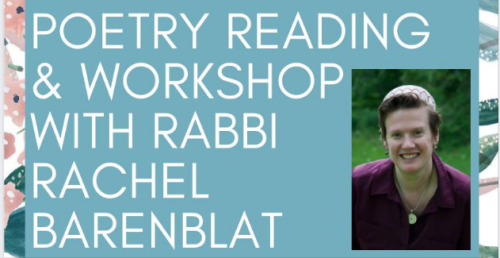
Next week I'm heading to Oberlin College for a whirlwind one-day visit that will include a lunch with Oberlin College Hillel, an afternoon psalm-writing workshop, and a poetry reading. All three of these are taking place on Tuesday, October 9.
If you're nearby, I hope you'll join us. The poetry reading is at 8pm on October 9 in Hallock Auditorium and dessert will be provided -- learn more and RSVP on Facebook.
Deep thanks to Rabbi Megan Doherty for inviting me! I'm looking so forward to meeting everyone there and to sharing some Torah and some poetry with that community.

October 1, 2018
Seven songs
1.
Such abundance! Sunlight streaming
golden as chicken soup, rain
that comes in its season, profusion
of produce at the farmer's market,
the way our hearts spill over
when we see someone we love, the way
Your heart flows to each of us.
2.
Bless boundaries. Bless the chutes
that control the flood, the walls
that protect from harm. Bless
integrity holding firm.
Bless the strength to stand tall
even in the face of storms:
to bend, and not to break.
3.
Balance us, God, like angels
dancing on the head of a pin.
Sing with us in harmony
and let our voices become more
than the sum of their parts.
When we match kindness with justice
the beauty takes my breath away.
4.
Because we wake every morning
and start again. Because in
putting one foot in front of the next
we learn and relearn how to walk
in Your ways. Because nothing
worth doing comes easy. Because
when we keep going, we aim toward You.
5.
No more than our place, no less
than our space: when we manage that,
we shine with the sun's own splendor.
Remind us that we are cloaked in skin
but made of light. Remind us
that through our best actions
Your glory shines, Majestic One.
6.
Our roots stretching deep.
Our foundations. Our generations.
Our teachers. Our drive to create.
Our students. Our readiness to open
our hands and let Torah through.
Our lives the foundries where we shape
our tradition into something new.
7.
Where heaven meets earth, where I
meet you, where reality meets redemption
we dance like the psalmist, exulting.
Our eyes well up with a mother's joy:
look, all of our exiled parts
ingathered beneath this leafy roof,
safe beneath the wings of Shechinah.
These poems were commissioned by Temple Beth-El of City Island, and were first heard aloud there last night at their Shemini Atzeret / Simchat Torah celebration.
Written to accompany the seven hakafot (circle dances with the Torah), they map to the seven "lower" sefirot: chesed (lovingkindness), gevurah (boundaries and strength), tiferet (balance and harmony), netzach (endurance), hod (humble splendor), yesod (roots and foundation) and malchut (Shechinah.)

September 30, 2018
First Build
We’re all stardust, re-mixed chemical elements forged in some distant supernova. We’re all broken shards, fallen from the primordial shattering. We’re all reflected light, glimmering with the Source of Light. We’re all builders, making and re-making the world one brick and one breath at a time.
Whatever your metaphor for who we are and what we do, your metaphor probably grounds in the foundation of some first principle – some First Build of mind and identity.
For us at Bayit, our first principle is that we – us and you – are builders of the Jewish future. So this year, for a whole year, we’ll mine Torah’s wisdom for lessons about building and builders.
As the Torah cycle begins anew with Parshat Bereishit, we begin as Torah begins – with the primordial building story that is the Creation at Torah’s very beginning (“a very good place to start“). One translation opens, “When God began to create heaven and earth, the land was a jumbled mess, with darkness on the face of the deep. And the spirit of God hovered…” (Gen. 1:1-2). Then came light, sky, sea, land, vegetation, stars, sun and moon, fish and birds, land creatures and first humans – a primordial building of sorts.
Reading this Creation story through a builder’s lens, we needn’t be architects or contractors to find a master plan for how to build. Here are seven foundation principles for building the Jewish future...
This week we're reading parashat Bereshit -- the first portion in the Torah -- and we're launching a new series on Builders Blog. Each week a different person will share thoughts on the weekly Torah portion, drawing out themes of building. Our first installment comes from Rabbi David Markus, and it's a gorgeous post about seven principles for builders (enriched by sketchnotes from builder Steve Silbert!) Read it here: First Build: Seven Foundation Principles for Spiritual Builders.

September 29, 2018
Small scenes from a sukkah
I got a new sukkah this year.
A simple white metal frame.
Three canvas walls with windows in them.
Cornstalks overhead, twined with autumnal garlands.
In the mornings, when it is not raining, I sit here
and watch the morning light move across the valley.
Sometimes I sing the psalms of Hallel.
Sometimes I sip coffee.
During the afternoon I listen to the wind rustle the cornstalks
and the tinsel garlands overhead.
Every now and then I listen to a small plane overhead,
or a flock of geese.
As afternoon gives way to evening,
the sky goes through its rapid costume change.
If I'm paying attention at the right moment
I can see it happen.
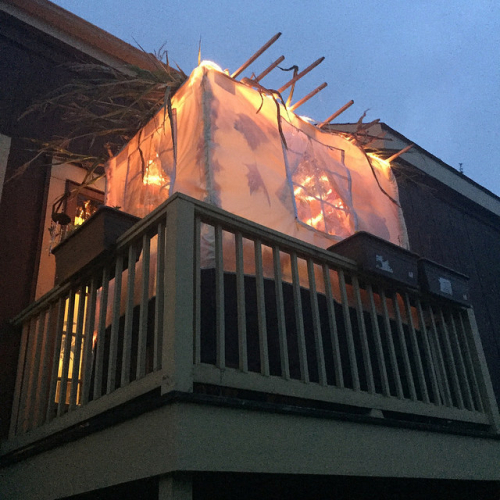
Once evening falls
the sukkah gleams
on my mirpesset,
a little house filled with light.

September 26, 2018
Six values for building the Jewish future
...It’s not only “do it yourself” (DIY) Judaism, but that there’s no other Judaism except DIY. The Jewish call is the call to do. “All” are called to “make” Shabbat (Ex. 31:16); same for tzitzit (Num. 15:38); same for a sukkah. To Rabbi David Ingber, “We need a Judaism with calluses on its hands and dirt under its fingers.” Essentially, we need a Judaism with builders’ hands.
That’s our first principle: we’re all builders. In Talmud’s words, “and all Your children will be … builders” (B.T. Berakhot 64a). Everything we do must inspire and support the universal call to build, the experience that is the foundation of Jewish life....
That's from a new post by Rabbi David Markus at Bayit's Builders Blog. Our work is driven by the principles of radical inclusion, "backwards compatibility," listening to "non-experts," rotating leadership, designing to be "crash-flex," and keeping our feet firmly on the ground.
Read more: Keystone values for building the Jewish future.
(And thanks to builder Steve Silbert for the sketchnote!)

September 25, 2018
Dear survivors: I see you, and I believe you.
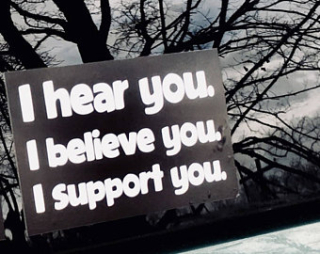 This post may be triggering for survivors of rape and sexual abuse. If that is you, please guard your boundaries carefully.
This post may be triggering for survivors of rape and sexual abuse. If that is you, please guard your boundaries carefully.
So many of the women I know -- my friends, my loved ones, my congregants, my colleagues -- are survivors of rape or sexual assault. It's everywhere. It's an invisible epidemic that is only now beginning to come to light.
And right now the national news is so saturated with it that all of those women are navigating trauma all over again.
From a president who bragged about grabbing women by our private parts, to a potential Supreme Court justice now multiply accused of sexual assault, to Jian Ghomeshi's recent essay, to a long list of actors and comedians and public figures accused of sexual misconduct: our discourse is consumed by conversation about the damage that women endure.
Encountering this subject everywhere can be re-traumatizing for victims of rape and sexual assault. Making matters worse, the public sphere is full of argument about whether or not to believe women when we take the risk of telling the truth about the harm done to us. The excuses, the gas-lighting, and the victim-blaming compound the trauma and the damage.
I simmer with constant low-grade nausea and grief and rage about this. This moment in time is so hard for my friends and loved ones, congregants and colleagues, who are survivors. This moment in time is hard for me.
One woman who is dear to me tweeted recently, "My body is on hyper alert, absorbed with past experiences, and I wonder - how many of us are just battling to stay upright right now?"
Dear survivors who are reading this: I see you and my heart goes out to you.
I believe you.
I believe you, and I see that you are hurting now. I see you struggling to get through the day, I see you unable to sleep or plagued by nightmares, I see your body clenched and on hyper alert.
I recognize that you can't take a sick day from work just because the current news cycle is constantly triggering you. I recognize that re-activated trauma may be slowing you down, making ordinary things difficult, making every day a struggle.
I am sorry beyond words for what you endured, and for what you are enduring now as the national news cycle thrusts these subjects into your awareness again and again.
I also see that you are more than your victimhood, and I honor that, too.
Dear survivors who are reading this: please don't carry this burden alone. Post-rape PTSD is real and is deeply damaging. There are some suggestions in the article How to Cope with Rape-Related Post Traumatic Stress Disorder, and I can offer anecdotal support for the positive benefits of several of the items on that list. I hope that you have (or will seek) a trustworthy therapist, ideally one trained in helping survivors navigate these issues. You might also seek a support group, so that you aren't alone.
(There's an excellent list of Resources for Sexual Assault Survivors and Their Loved Ones online at RAINN.)
*
I pray that something good will come out of this moment's painful focus on rape and sexual assault.
May we shift the broader culture so that the women's voices, experiences, and bodily integrity will be honored.
May we teach our children about active consent, and may we relegate "boys will be boys" and "this is just how men behave" to the trash. Boys and men can and should be better than this.
And may all who are survivors of rape and sexual assault find healing.

September 19, 2018
What the labyrinth helps us see
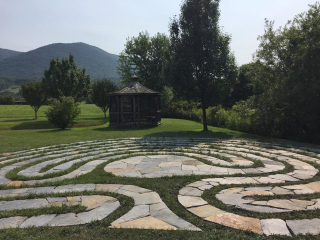 A few weeks ago, while the Al and Frances Small Memorial Labyrinth was still under construction, my eight year old son was with me at synagogue and ran outside to explore it. He immediately wanted to walk its spiraling path. And I asked him whether he knew what made a labyrinth different from a maze.
A few weeks ago, while the Al and Frances Small Memorial Labyrinth was still under construction, my eight year old son was with me at synagogue and ran outside to explore it. He immediately wanted to walk its spiraling path. And I asked him whether he knew what made a labyrinth different from a maze.
He thought about it for a moment, and then said, "You can't get lost in it."
He's right. A maze is designed to confound and confuse. Think of the hedge mazes on elaborate European estates, or the placemat mazes that challenge you to draw a path from entry to exit without lifting your pen. A labyrinth is something else entirely.
In a labyrinth, there's only one path. It goes all the way in, and then you turn the other way and it goes all the way back out. The purpose of a labyrinth isn't to see whether you can figure out where you're going, because there's only one footpath. The purpose of a labyrinth is to attune you to where you're going, and how you're going, and how the path twists and turns.
As some of you have seen, we have a beautiful new meditation labyrinth outside our sanctuary. It was designed by Lars Howlett, a professional labyrinth designer -- yes, that's an actual profession -- who came to CBI and walked our land and selected a shape that is suited to our grounds. Deepest thanks to Bill Riley for transferring the design to the ground, to Valerie Ross and Josh Goodell of New England Lawn and Garden Care for stonework and installation, and to Cheryl Small for her generosity.
Our labyrinth has seven circuits, which is a traditional shape for Jewish labyrinths. Seven is a meaningful number in Judaism: the seven days of creation. There are seven colors in the rainbow. There are seven qualities that we and God share, which we meditate on and cultivate during the seven weeks of the Counting of the Omer between Pesach and Shavuot -- and some of us do this during the seven weeks between Tisha b'Av and Rosh Hashanah, too. In a Jewish wedding, the partners make seven circuits around each other, and we hear seven blessings. At a Jewish funeral, the pallbearers pause seven times en route to the grave.
Some look at our labyrinth and see the Tree of Life, another one of our tradition's great metaphors for divinity: we enter at the roots and walk all the way into the crown. Some look at our labyrinth and see the crenellations of the human brain. All of this informed the design of our labyrinth.
A labyrinth serves to remind us to pay attention to the journey, not the destination. If I wanted to reach the center of the labyrinth quickly I could walk across, from one stepping-stone to the next, directly inward. Four or five big steps and I'd be there. But that defeats the purpose. It's not about how quickly I can get there. It's about the feeling of my feet on the pavement, and how the view changes as I move along the path. It's about how sometimes it feels like my goal is tantalizingly close, and then the path swerves and I'm heading in an entirely different direction from what I expected. It's about surrendering to the journey.
I have to pay attention to where my feet go on the path, and that serves to mostly keep me in the moment, in this place, in this here-and-now. And even if I can see the journey's end when I begin it -- even if I lift up my eyes and see the switchbacks and turns that await me before I reach the center -- I don't know how it will feel to walk the path until I actually do it. And I don't know how walking it this time might feel different from walking it that time.
A meditation labyrinth is an embodied metaphor for spiritual life -- for all of life, because all of life is spiritual whether or not we call it so. Here are four things that our labyrinth keeps teaching me:
1) How we get there is as important as where we are going.
2) Every journey has unexpected twists and turns. We may think we're headed in one direction -- a job, a marriage, a happily-ever-after -- and then it turns out we're headed somewhere entirely different.
This is true not only on an individual level, but a collective one. Of course, on a national level the metaphor breaks down, because we aren't locked in to a single labyrinthine path. But the emotional experience of being an American these last few years has felt a little bit like walking the labyrinth -- wait, you mean we're going this way? -- and it demands some of the same patience as walking the labyrinth. There are no short-cuts to the center. The only way to get where we need to go is to keep on walking.
3) The labyrinth reminds us that we can't hold still. Everything passes. Sometimes this is grief-inducing: I'm so happy right now, and I never want that to go away, but I know that it will. And sometimes it's a profound relief: I'm in the narrow straits of despair right now, but I know I won't be here forever. But if we work at it, we can learn to draw comfort from the fact that everything changes.
4) What we see depends on where we are. In a physical sense, this means that our view changes depending on how much of the labyrinth we've walked: we're gazing at the mountains, no, at the gazebo, no, at the wetland, no, at the shul. In a metaphysical sense it's equally true.
Yom Kippur is like a labyrinth. You can't get lost in it: there's only one path through. It began last night and it will end tonight. Over the first half of the day we're moving ever deeper in, and over the second half of the day we're moving slowly back out again.
It's the same path every year. We start with Kol Nidre. We end with that final tekiah gedolah. In between we reach the same touchstones, the same stories and Torah readings and prayers.
And every time we walk it, we are different. We bring the sum total of our life experiences to Yom Kippur, and every year we have grown and changed since the year before.
If you think about Yom Kippur in terms of where it "gets you," it may not seem like much of a destination. It's not a cruise or an adventure, a birth or a wedding or a promotion. But if you think of Yom Kippur as an opportunity to see yourself more clearly, then it's an entirely different kind of journey.
After our closing song we'll break until 3pm when we'll gather for contemplative practice, followed at 4-ish by mincha and a talk from Hazzan Randall, followed at 6:30 by Ne'ilah, our closing service. I hope that some of you will choose to stick around, or to return early, or to take advantage of the break before or after mincha -- so that you can walk the steps of our beautiful new labyrinth, and see what unfolds in you on this holiest of days and most beautiful of places. May the rest of your Yom Kippur be meaningful and sweet.
This year my shul's theme for the Days of Awe is Vision. My sermons reflect and refract that theme in different ways. This isn't one of my three formal sermons, but it touches on the theme even so.
Cross-posted to my From the Rabbi blog.

Rachel Barenblat's Blog
- Rachel Barenblat's profile
- 6 followers


